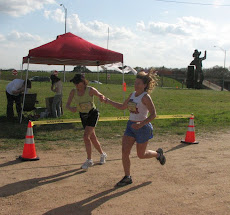It is certainly possible to train without a heart rate monitor. You can always pause and get a pretty good estimate of your heart rate as you are working out. But the benefit offered by a heart rate monitor is that you don’t have to pause, you are monitored constantly, and you can produce a report after the workout which gives some interesting statistics which can help you plan a more effective next workout.
I won’t get into detail here but I would love to hear from anyone who can speak with experience and authority (Shelly Campbell, are you out there?). Suffice it to say that I have exercised off and on with a heart rate monitor for much of the last 4 years, and I find it very useful. Heart rate, more than pace, has dictated my marathoning experiences. This might not be the end all method, but I think it has generally served me well on race day.
Now I am discovering even better ways to use my monitor. There are formulae, based on one’s age, which allow an athlete to identify certain ranges of heart rate which then translate into various levels of results. For example, I am 58 years old. One of the often used equations is 220 minus your age to determine your max heart rate. You then use that number to determine a heart rate “zone” for weight loss, cardio, etc. The range is something like 65-85% of your max heart rate. Using this basic formula I find that for cardio work I should strive for a workout heart rate of (220-58)x.75=121 bpm (here I use 75%, or right in the middle of the workout range). Experience has shown me that this is too conservative. However, the conundrum is that if you disregard your “ideal” and instead overwork, you end up with less return on your workout.
I recently saw another formula (Target Heart Rate Calculator) which is supposed to distinguish whether you are in shape or out. Using this calculation I am advised that my 75% workout should be done at 132 bpm. That’s better, and forces me into a more vigorous workout. But in the end, these are generalized estimates which may lead you astray. I have heard that the numbers produced by the formulae can be off by as much as 10%, maybe more.
This is why I was thrilled recently to undergo VO2 testing at Spectrum Athletic Clubs here in San Antonio. Many health clubs are set up to conduct VO2 testing and I would assume the results obtained from one source will not vary greatly from the test results elsewhere. In the interest of full disclosure, Spectrum agreed to test me for free as I work with my colleague Diane Berlanga on a podcast feature about several of the fitness tests offered by Spectrum and others.
I am still learning exactly how the results are derived from the tests. Suffice it to say that one is fitted with a mask through which expelled air is measured and analyzed. My test was on a treadmill which varied the intensity of my 15 minute workout. I began easily and eventually was paced up to a jog, then to the max, anaerobic, level. The information was then processed by a computer program and customized heart rate parameters were produced for me. What I have learned is that my gut reaction pre-test was correct. I can and should work out at a higher heart rate level than the formulae would indicate. It is said that much of this is genetic predisposition(thanks, Mom and/or Dad), though I imagine there’s also some reflection of one’s fitness level. The important thing is that I now can more accurately monitor my workout levels for highest efficiency.
We all wonder from time to time whether we are working as hard as we should be. I have always known that I could work harder by ramping up how often I run, swim, bike or otherwise work out. But what I have not known previously is how hard I can and should go within a workout. Now I do know. Of course, there’s still the matter of implementation.
Bottom line: if you are interested in getting more out of your aerobic activity, purchase and use a heart rate monitor. A number of manufacturers make them, though Polar is probably the leader in the industry. Check the various models carefully and make sure you get everything you need, and then some. If you are a techie, like me, you will not regret spending a little more in order to have more features. I have had very good service from the first monitor I bought, but not such good experience with a biking specific model which would interface with a pickup on the bicycle to measure speed and distance. This never worked reliably for me, and the watch part of the system proved not very waterproof for swimming. As I was saying earlier, choose carefully the features which you need for your particular sport or sports.
The final bottom line: if you are really getting serious about fitness and are competitive with yourself (or others) to achieve more, splurge on VO2 testing and then USE the gathered knowledge.
Read More......



